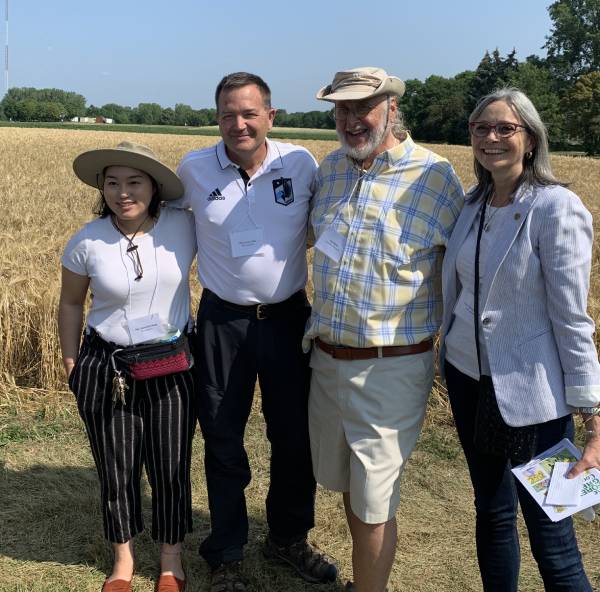
Steve Morse, Minnesota Environmental Partnership
It’s with a heavy heart that I write about the passing of University of Minnesota Agronomy Professor Don Wyse. Don died on July 2nd, after suffering major injuries in a fall. I ask all to join me in remembering Don and sharing sympathies with his family.
Quite simply, Don was a giant in reshaping both the ever important and powerful agricultural as well as the University of Minnesota systems. I had the honor of working closely with Don for about the last 30 years. And just as he did for so many people, this weed scientist changed how I viewed both of those systems and how I worked to change the world for the better.
The vision that Don pursued for the next generation of agriculture is nothing less than the Green Revolution 2.0. – taking the work of the University’s Nobel Laureate Norman Borlaug to a higher level.
Moving beyond the industrial agricultural model focused on optimizing production of corn and soybeans, Don led the conceptualization and development of agricultural cropping systems that much more closely mimic those critical natural ecological systems on which we all depend. He did this with “continuous living cover” crops, which, unlike conventional row crops, keep the soil covered with vigorous, growing plants throughout the growing season.
This approach is designed to result in superior ecological benefits like clean water, healthier soil, improved habitat and climate resiliency. It also provides the ever-important benefit of marketable crops that create the income to make these systems durable and appealing to farmers.
In recent years, this work was done under the auspices of Forever Green, the University of Minnesota initiative for which Don was the co-founder and co-director. You may know of some of the initial releases from this work, such as Kernza, the world’s first viable perennial grain crop, now in grocery stores and increasingly used in beer and prepared foods. Another major regenerative crop starting to roll out is Winter Camelina, which produces a valuable oil with strong potential for replacing fossil fuels in transportation.
For more than a decade, MEP and our allies have worked with lead member organizations Land Stewardship Project and Friends of the Mississippi River, to gain support and funding for Forever Green, securing over $22 million in state funds to support this critical work.
But Don’s vision was bigger than just developing new crops. He also helped lead the development of new and innovative ways to bring people together and bring community voices into decision making spaces.
I first met Don while I was serving as Chair of the Environment and Agriculture Funding Division in the Minnesota Senate. I was skeptical of the direction of much of the University of Minnesota’s agricultural research and questioned how it benefited the greater good, wondering what had happened to its Land Grant mission. In Don, I found a kindred spirit who shared these concerns but who was also rolling out models for how to integrate diverse community voices into the University decision making process.
We first collaborated on funding for the Minnesota Institute for Sustainable Agriculture, which brought farmers and advocates together with the University to support sustainable agriculture. Multiple MEP member organizations are currently actively engaged with this Institute. We then partnered to launch the next iteration of Don’s vision, the Regional Sustainable Development Partnership, with regional community-based boards located across the state, linking University programs with community priorities to support sustainability. This was followed by the development of the Green Lands, Blue Waters project which linked Land Grant Universities along the main stem of the Mississippi River with NGOs to develop and support a transition to continuous living cover agricultural systems. All of this was before the launch of the more Minnesota focused Forever Green Initiative.
Forever Green is proving to be transformational, not only for its promising new cropping systems, but also for its way of operating. In order to drive the array of changes needed, Don understood that we couldn’t just keep doing what has always been done. He created novel space and capacity within the University to develop teams and pursue big picture ideas that served the greater public good. And he continuously reached out and engaged new partners, educating them, and learning from them, as he went.
Don thrived on a steady stream of engagement whether it be farmers, community people and processors to corporate institutions, elected leaders, agency staff, funders, a wide range of NGOs, other researchers and academics. This is the “secret sauce” that distinguishes so much of Don’s work. He wasn’t satisfied with just developing new plant materials. He formed the networks and partnerships to not only support work on a wide range of “Continuous Living Cover” crops, but also set up systems to support the commercialization of these crops from farm field to kitchen table or whatever the end use may be.
Don created new models for the future of regenerative agriculture and our Land Grant University – something critically needed by both systems. Our challenge will be to lift up this work, and see that it not only continues, but ramps up, to meet the pressing needs of today for the protection of our soil, water, and habitat and the prosperity of our farmers and communities.
Within the last few days, the Star Tribune ran two wonderful articles related to Don. The first was a profile of his life and work, and on the front page two days later, an article about Winter Camelina, one of the most promising crops springing from Forever Green. Together, they say a lot about Don and the Green Revolution 2.0.
A Celebration of Life for Don Wyse will be held at the UMN McNamara Alumni Center on July 26th at 2 pm, followed by a reception. All who knew, worked with and appreciated Don are welcome to attend. Memorials are being accepted for a scholarship fund in Don’s name: https://everloved.com/life-of/dr-donald-wyse/donate/